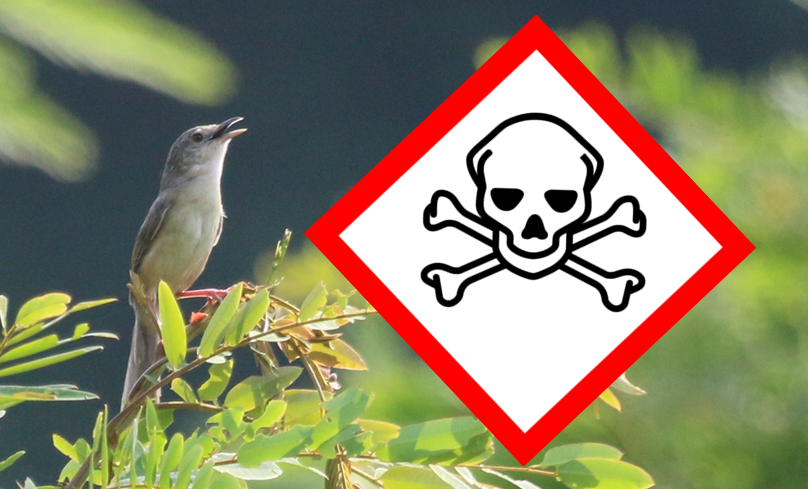
It must suck to be called “Brown Prinia“. Try as I might, I can’t think of a name that implies more boredom and more unattractiveness, and is less apt at attracting the interest of birders. From a birder’s perspective however, this is both a shame and a blessing, as I will show below based on my observations of the species on the island of Java in November.
The prinias are a group of around 25 Old World warbler species found in Africa and Asia. Within the Old World’s brown warblers (of which there are more than anyone would want there to be), they are distinct in that they have very long tails. However, they are indistinct within the Old World’s brown warblers in that their plumage consists entirely of different shades of brown. Therefore, calling a species “Brown Prinia” is a painful double dose of indifference from the scientists’ side, and I doubt the species was ever very high on the target list of birders visiting its distribution range. Many birders might regret this one day. Other birders might however owe their very lives to this neglect.
The classic habitat of the Brown Prinia on Java. I wonder if the Brown Prinia would have been named differently if it lived in attractive primary rain forests instead.
Let me first deal with the regret. The Brown Prinia is an Asian species with a very peculiar range. It inhabits rather dry areas within a region notorious for being one of the rainiest parts of the world, and is thus patchily distributed from Burma through Laos, Cambodia, parts of Thailand and south China, all the way to Vietnam. Then there is a gap of around 2,000 km (or 1,200 miles). And then there is the island of Java which also has Brown Prinias – of a different subspecies! Surprise, surprise. This is actually a distributional pattern it shares with a number of other SE Asian taxa. Java has a comparably dry climate and therefore supports landscapes similar to dry savannas found in the more northerly countries named above, but not on the islands of Borneo and Sumatra, its immediate neighbours. These Java populations have increasingly been elevated to species level, providing Java with a soaring number of endemics. It would therefore not surprise me in the least if this is where the Javan Brown Prinias are headed – so long as a scientist will take interest in the taxon in spite of its name. Now, endemics and splits are not amongst the things birders tend to dislike. However, the vast majority of Java’s endemic bird species inhabit what is left of the island’s rain forests, and birders therefore tend to limit their visit to Java to a few selected national parks in mountainous regions – which is where the Brown Prinias are not to be found. Chances are that a future split will therefore not give birders an armchair tick but a painful gap on their list for an area they have already visited and hadn’t planned on visiting again. Additionally, this split would mean that birders need to cut their time short in prime habitats to allow for sufficiant time in degraded, littered shrubs that hold little else that is of interest to them – just the Brown Prinia. A small brown bird.
After three lengthy paragraphs, I figured it was about time I showed you what this post is about: a Brown Prinia. Boy, this pic (and bird) was surely worth the wait.
Now I get to the life-saving aspect of having missed Brown Prinia on visits to Java. This species, as small and as brown as it may be, does not seem quite as harmless as its looks suggest. On the contrary, it may very well be one of the most dangerous bird species in Asia, if not the world. So, move over Cassowary. This is not about a good kick to a birder’s abdomen. This is about something much more hideous: venom!
Yes, indeed. My observations suggest that the Brown Prinia is the only bird species in the world capable of inflicting a venomous bite to unsuspecting birders. And judging by my data and the fact that no birder has ever been admitted to a hospital after such a bite, I would guess that the venom is highly potent with a fatality rate of 100%, and death occurring within a few minutes of the bite. Thankfully, all venomous species which tend to bite in defense have mechanisms in place to warn intruders, not so much to safe the intruder’s life but to save the venom for a hunt. In the case of the Brown Prinia, this warning mechanism is the colouration of its mouth. Please, take a close look at the following image of a Brown Prinia in threat display.
Look at the colour of the mouth: it is pitch black! Now, what does that remind you of? Exactly, the Black Mamba, one of the world’s most dangerous snakes! Here is a little comparison (Black Mamba courtesy of Tad Arensmeier and Wikipedia, and excuse the horrible prinia crop):
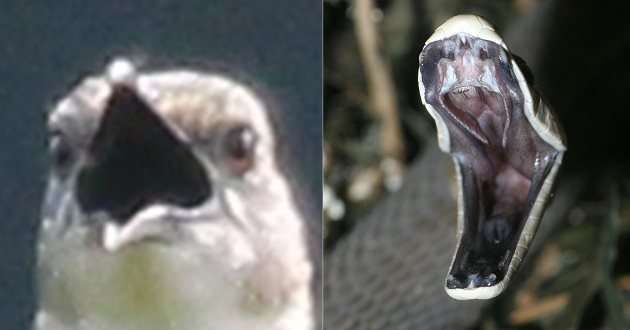 Disturbing, right? Let this post be a fair warning to all birders visiting Java: it may be perfectly safe (if ethically questionable) to sneak up on a bird as close as possible to take a picture, closer and closer until it flies off. Just don’t try this with a Brown Prinia, unless you have life insurance and a family in need.
Disturbing, right? Let this post be a fair warning to all birders visiting Java: it may be perfectly safe (if ethically questionable) to sneak up on a bird as close as possible to take a picture, closer and closer until it flies off. Just don’t try this with a Brown Prinia, unless you have life insurance and a family in need.
Okay, I may have misinterpreted a few colour patterns here or drawn conclusions where I should have drawn doodles instead. But on a more serious note, back on Java in November I was struck not so much by a prinia’s venomous fangs but by this very conspicious and apparently quite rare colouration. I have never seen anything like this in a bird species, and am not aware of any other species that show such a colouration.
What about you? Do you know anything about it, or are aware of other bird species with such a striking colouration?
.
“It’s charging!!!”
.

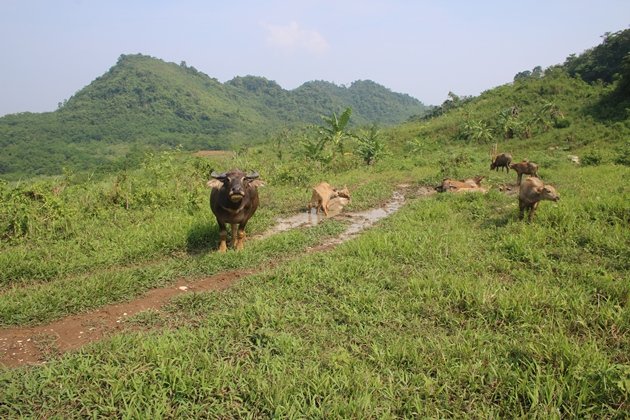
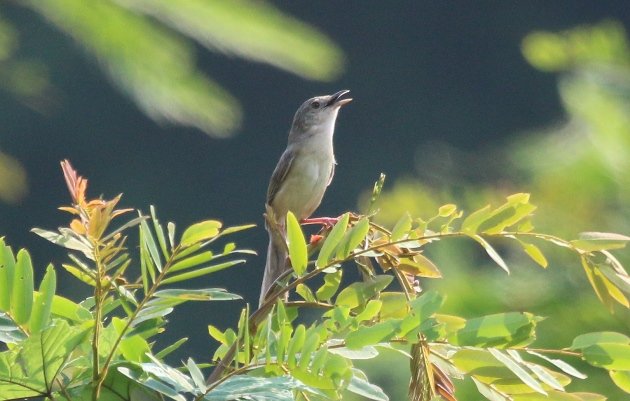
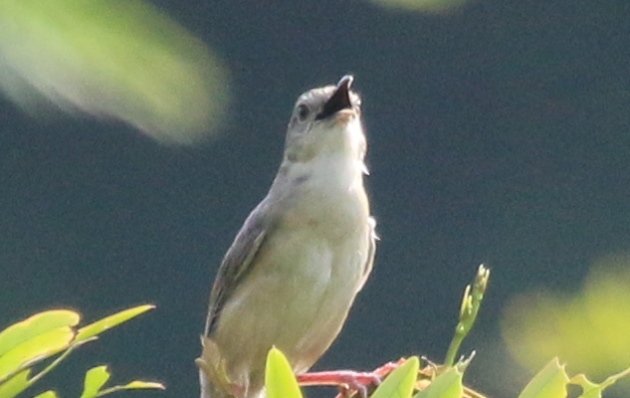
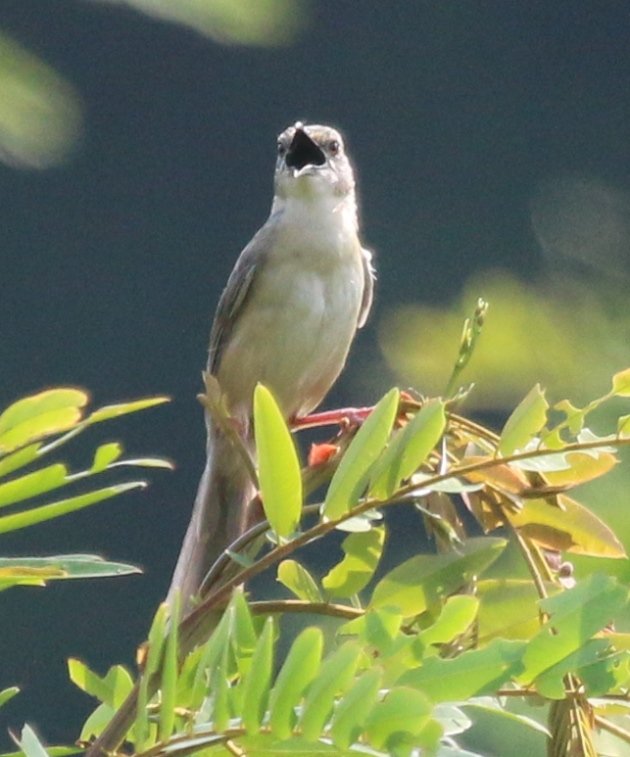










I am far from an expert, but I do remember seeing a Rattling Cisticola in Zambia with a similar black mouth. It was very striking, unfortunately I have no photographic evidence.
A quick internet search also showed up Stout Cisticola with a similar feature on this page: http://antpitta.com/images/photos/non-neotropics/kenya/aug-sep-2012-birds/gallery_kenya_2012_birds6.html.
Rattling Cisticola at this webpage: http://www.biodiversityexplorer.org/birds/cisticolidae/cisticola_chiniana.htm
Ha ha, thanks for the laughs…and nightmares of Brown Prinias attacking like Black Mambas!
You know of course about the Hooded Pitohui of PNG?
I agree with Cynthia – I have notes on seeing a black mouth on
a Rattling Cisticola (mine was in Kenya) that was singing. I had never seen a bird with a black mouth before that trip.
Harriers have striking black mouths too, at least marsh and Montagu’s harriers. Their tongue looks like a cyanotic one and the mouth roof is pretty black. The first time I saw one of them I thought it has been poisoned, as cyanotic tongue is a common sign of coagulation disorders induced by some toxics.
To all: thanks so much for the great comments! I might turn this into a follow-up post! Cheers, have an amazing holiday season and a great start nto 2015!!